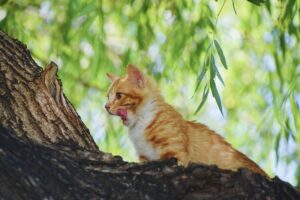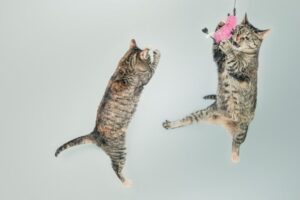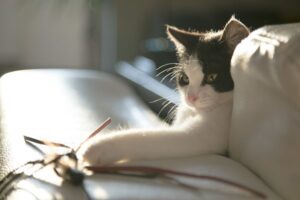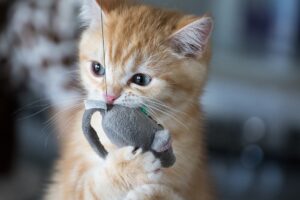Cats are animals that spend their days lounging around. Therefore, they tend to lack exercise if left alone.
Lack of exercise is not only bad for a cat's health but also a cause of stress.
Daily exercise is essential for their physical and mental health.
However, getting a cat to exercise is not straightforward.
Therefore, this article introduces tips on how to skillfully engage even the least active cats in play.
Contents
1. Engage cats in instinctive hunting without unnecessary exercise
∟1-1. The instinct to lounge and the desire to hunt
∟1-2. Stress from not being able to hunt leads to problematic behavior
2. The trick to successfully engaging cats in play is to become the prey
∟2-1. Play before meals. Catching the prey is the key
∟2-2. Choosing toys to satisfy the hunting instinct
∟2-3. Move the toys in a way that makes the cat want to attack
3. Be cautious of cats swallowing or eating toy parts
Conclusion
1. Engaging in natural hunting behavior without unnecessary exercise

The best way to encourage a cat to exercise is to utilize its instincts.
First, let's review what kind of creature a cat is.
1-1. The instinct to lounge and the desire to hunt
As you may know, cats are carnivores and originally hunted small animals like mice and lizards, as well as insects.
However, since prey animals are also fighting for their lives, they are not always easily caught.
Therefore, cats remain still except when hunting to conserve energy for when the need arises.
In other words, lounging around is also part of their instinct.
On the other hand, hunting is an instinctive behavior. While some of it is learned from their mothers when they are kittens, the instinct to chase, capture, and eat prey is inherent.
Therefore, cats can't resist chasing small moving objects.
1-2. Stress from inability to hunt leads to problematic behavior
Unlike feral cats that hunt for their food, indoor cats receive ample food without needing to hunt.
As a result, their hunting instinct is not utilized, while their lounging instinct is overly expressed.
In other words, they remain mostly inactive, conserving energy.
It's no surprise they become under-exercised.
Moreover, constant lounging without fulfilling their hunting instinct leads to stress.
This stress can manifest as running around the house at night.
This is commonly referred to as the "nightly marathon."
If it were just the nightly marathons, it would be tolerable, but sometimes the hunting impulse can be directed towards nearby living beings.
Even a usually calm cat might suddenly bite or scratch their owner, leading to problematic behavior.
To prevent such issues, it's necessary to ensure the cat gets adequate exercise.
But again, this is easier said than done.
2. The trick to engaging cats in play is to become the prey

Since cats have a natural instinct to lounge, they do not enjoy unnecessary exercise.
The way to get such cats to exercise is already clear.
That's right. We need to stimulate their hunting instinct.
Or rather, there's no other way to get a cat to exercise than by stimulating its hunting instinct.
2-1. Play before meals. Catching the prey is the key
Why do cats hunt? Of course, to eat. Catching and eating prey is one set.
Therefore, the best time to play with cats is before meals or snacks.
However, cats are burst energy types and do not have much stamina.
Therefore, short playtimes are fine.
A few minutes of play, with breaks, is sufficient.
If the cat starts breathing heavily or lies down, it's time for a break.
It's important to remember that the purpose of the play is not just running or jumping, but to satisfy the hunting instinct.
Since hunting involves chasing, catching, and eating, it's essential to let the cat catch the toy representing prey and then 'eat' it.
Otherwise, the hunting instinct won't be satisfied, and it won't serve as a stress reliever.
Of course, you can't actually feed the toy to the cat, so you wrap up with a meal or snack instead.
By playing in a way that aligns with their instincts, you can satisfy the cat and also address its lack of exercise.
2-2. Choosing toys to satisfy the hunting instinct
The prey of wild cats includes small rodents, lizards, snakes, frogs, small birds, and insects. They also preyed on larger animals like rabbits and pigeons.
Therefore, many cat toys are designed with these preferred prey in mind.
For example, small stuffed toys represent mice, a favorite prey of cats.
When playing with this type of toy, cats typically exhibit behaviors like clawing to capture, pressing down, and biting.
Toys using bird feathers or modeled after butterflies and bees are also common.
These are recommended for cats attracted to fluttering movements.
Ball toys simulate chasing fleeing prey, while kick toys evoke the action of weakening captured prey.
However, what type of toy a cat prefers depends on its individual personality.
Therefore, try different toys and find the one that suits your cat.
2-3. Moving toys in a way that entices cats to attack
Of course, the way you move the toy should also mimic the movement of prey.
It's not just about waving it around.
Rather than moving at a constant speed, the movement should be erratic, stopping and starting irregularly.
Frequent changes in direction are also effective.
Think like the prey trying to evade a predator (the cat) and experiment with different movements.
When moving the toy, focus on whether the cat is interested.
Check if the cat is watching the movement of the toy or, even if not looking, is pointing its ears towards it.
A cat ready to attack its prey will adopt a low posture and prepare to pounce.
This indicates that the toy selection has been successful.
If the cat is not responding well, it could mean that it doesn't like the toy or the way it's being moved.
Therefore, trying a different toy or changing the way you move it might be helpful.
Being mindful of these aspects in toy selection and play style should reduce the chance of the cat refusing to play.
When playing, be careful not to make it obvious that the owner is the one moving the toy.
This is because the cat might recognize the owner's hand as part of the prey, or an object to attack.
3. Be cautious of cats swallowing or eating toy parts

It's important to remember that hunting is a behavior meant for eating, and toys are not necessarily safe.
Since the purpose of hunting is to eat, there's a possibility that cats might try to eat toys.
Even if they can't swallow the whole toy, broken feathers or torn parts can be easily ingested.
Therefore, before playing, check if parts like limbs, tails, eyes, etc., of stuffed toys are not about to come off.
Of course, it's also recommended to recheck during and after play.
The stick part is also frequently chewed. Wooden sticks can break and become sharp, posing a hazard.
If you find cracks or splinters, cover them with tape or shave them off with a knife.
The string or ribbon connecting the 'prey' part and the stick is also prone to being chewed off, posing a risk of ingestion.
Therefore, it's safer to put away the toy when not playing together.
Especially be careful with favorite toys as they have a higher risk of ingestion.
Moreover, the safety standards for toys are significantly lower than for food, and there's a chance that harmful paints or dyes are used.
There are also cases where toxic substances are used to protect against bugs or mold during overseas transport.
If possible, washing or wiping the toy before play can reduce some of these concerns.
Conclusion
The key to successfully engaging cats in play is to stimulate their hunting instinct.
Understanding what to use as prey and how to simulate hunting makes it easier to choose toys and find engaging ways to play.
Also, playing before meals or snacks aligns the play with the natural pattern of hunting and eating, fulfilling the hunting instinct at a deeper level.
Successfully engaging your cat in play can reduce their stress and may prevent problematic behavior.
Of course, it also addresses the issue of lack of exercise, so give it a try.



